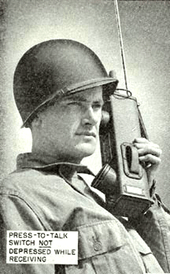SCR-536

The SCR-536 was a hand-held radio transceiver used by the US Army Signal Corps in World War II. It is popularly referred to as a walkie talkie, although it was originally designated a "handie talkie".[1]
History
The SCR-536 is often considered the first of modern hand held, self-contained, "handie talkie" two-way radios. It was developed in 1940 by a team led by Don Mitchell, chief engineer for Galvin Manufacturing (now Motorola) and was the first true hand-held unit to see widespread use.[1] By July 1941, it was in mass production. In November 1942, the SCR-536 received coverage in the amateur radio magazine QST. It appeared on the cover as well as in Signal Corps advertising, and was featured as part of an article on the Signal Corps. “Smallest field unit of the Signal Corps” in which a photo caption read; “it is not much larger or heavier than a conventional handset”. It was carried among the first waves to hit Omaha Beach at Normandy in June 1944.[2] Every rifle company of the U.S. 29th Infantry division had six; one for each of the three rifle platoons, two for the weapons platoon, and one for the company CO. The Germans were deeply impressed by the SCR-536 and the SCR-300 after capturing several units in Sicily.[3] By war’s end, 130,000 of the units had been manufactured by Motorola. They were also produced by other firms.
Today, the SCR-536 is often restored and operated by vintage amateur radio enthusiasts and military radio collectors.[1]
Specifications
The SCR-536, which incorporated five vacuum tubes in a waterproof case, had no separate power switch. Instead the radio turned on when the antenna was pulled out, and off when it was retracted.[4] The SCR-536 weighed 5 pounds with batteries and 3.85 lb without (2.3 and 1.75 kg). The unit operated in AM voice mode between 3.5 and 6.0 MHz frequency range. The SCR-536 had an RF output power of 360 milliwatts. The range of the unit varied with terrain; from a few hundred feet, to approximately one mile over land, and 3 miles over water. The short range is accounted for by the short antenna: on transmit it shows a low radiation resistance, so it couples to free space with low efficiency. The same is true on receive, with an alternative explanation: the shorter the receiving antenna, the less energy it can intercept ("collect"), and therefore deliver to the receiver.
Under the Army Nomenclature System, the BC-611 transceiver was the core component of the SCR-536 Signal Corps Radio set. The Signal Corps technical manual number was TM 11-235.[5]
Components
- BX-48 box for spare crystals and tubes (5-sets)
- BX-49 box for spare crystals and tubes (24-sets)
- BG-162 bag for batteries (BA-37, BA-38)
- CH-146 chest for equipment
- CH-233 chest for spare tubes, crystals, (400 items)
- CS-144 parachute case
- CS-156 canvas case
- CH-312 case for IE-37 tuning unit
See also
- ARC-5
- AN/PRC-6, post WW-II successor to the SCR-536.
- BC-348
- BC-654
- Collins Radio
- R-390A
- SCR-299
- Signal Corps Radio
- Wireless Set No. 19
- Vintage amateur radio
- SCR-694
References
- 1 2 3 "A Short History of the Handheld Transceiver". Archived from the original (pdf) on 2010-11-10. Retrieved 2008-04-01.
- ↑ "29 Let's Go! The Story of the 29th Infantry Division". Lone Sentry. Retrieved 2011-11-18.
- ↑ Balkoski, Joseph (2005). Beyond the beachhead: the 29th Infantry Division in Normandy. Stackpole Books. ISBN 0-8117-3237-1.
- ↑ "BC611/SCR536 Walkie-Talkie". Kurrajong Radio Museum. Waverley Amateur Radio Society. Retrieved 2011-11-18.
- ↑ "SCR-536 Walkie Talkie". Olive-Drab. Retrieved 2008-04-01.